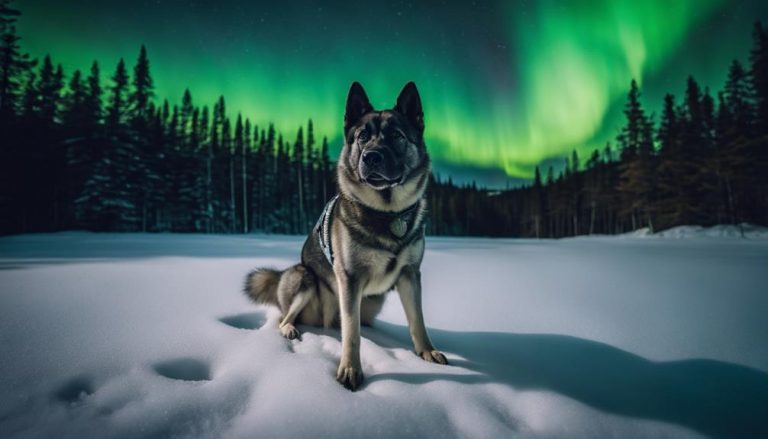Norwegian Elkhound Breed Characteristics
The Norwegian Elkhound stands as Norway’s pride, renowned for its dual role as a skilled hunter and a devoted friend. Tracing back to the era of the Vikings, this medium-sized breed boasts a sturdy frame and a dense, silver-gray coat, designed to take on large game under the unforgiving Nordic climate. Males are usually 20-22 inches tall at the shoulder and weigh between 45-55 pounds, with females being a bit smaller. These dogs shine with their smartness, courage, and flexibility, making them outstanding pets for families. They thrive with consistent exercise, a nutritious diet, and regular grooming. Key health issues to watch for include hip dysplasia and eye conditions, so proper care is crucial for their long-term health and happiness.
Care and Maintenance of the Norwegian Elkhound involves more than just love and attention. This breed’s thick coat needs regular brushing to stay clean and healthy, and their active nature demands daily physical activity to keep them fit and prevent boredom. Offering them a well-rounded diet supports their energy levels and overall health. Paying attention to their health by scheduling regular veterinary check-ups can help catch and manage common conditions early. With the right care, these loyal dogs can enjoy a full and vibrant life alongside their human families.
Key Takeaways
- Norway’s national dog, the Norwegian Elkhound, excels in loyalty.
- Bred by Vikings for hunting, it thrives in endurance.
- Needs regular vet visits for common health issues.
Quick Facts
The Norwegian Elkhound, hailing from Norway and honored as the nation’s National Dog, is classified within the Working group. This breed boasts a sturdy frame, with males reaching heights of 20-22 inches and weighing between 45-55 pounds. Females are slightly smaller, standing 18-20 inches tall and weighing 35-45 pounds. Known for their intelligence and loyalty, these dogs are perfect for families or individuals who can fulfill their need for daily exercise.
With a lifespan of 12-15 years, the Norwegian Elkhound is generally a healthy breed. Yet, it’s crucial for prospective owners to be mindful of health issues like hip dysplasia and eye conditions. These concerns underline the importance of choosing responsible breeders and ensuring routine veterinary care. Their thick coats, usually gray or black, not only contribute to their striking looks but also demand regular grooming to keep them in top condition and manage shedding.
Norwegian Elkhounds are incredibly affectionate and value human companionship, often developing deep bonds with their owners. They are best suited for those who lead an active lifestyle, as their high energy levels make them the perfect companion for outdoor adventures. This breed stands out for its blend of physical strength, mental acuity, and emotional depth, making it an excellent choice for those seeking a devoted and active pet.
Overview
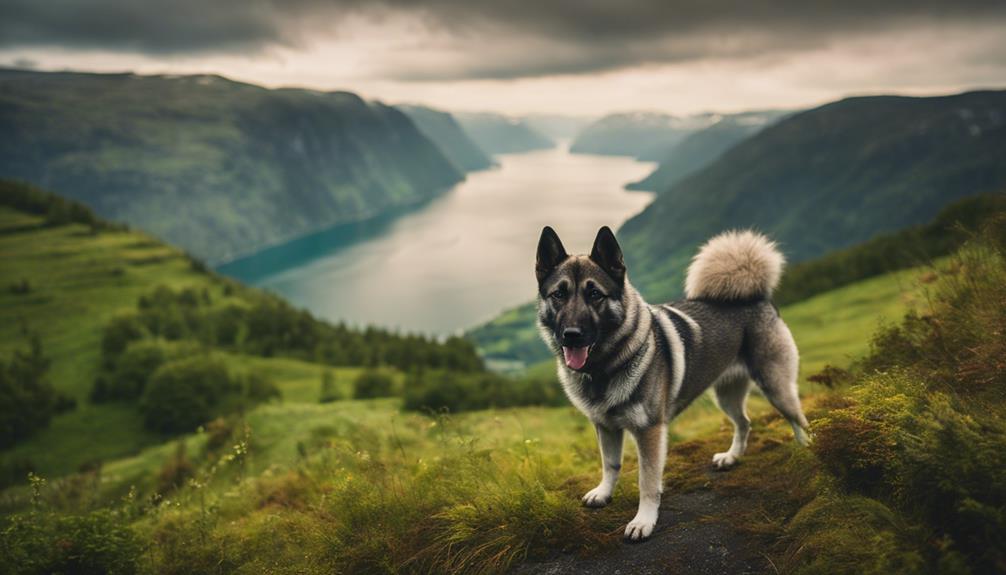
Norwegian Elkhounds, hailing from Scandinavia, were bred by Vikings for hunting large animals. These medium-sized dogs stand out with their strong yet nimble bodies, making them excellent hunters and great family pets. Their thick silver-gray coat protects them from cold climates and gives them a regal look. They’re friendly and strike a perfect balance between toughness and elegance.
These dogs have sharp senses and can endure long hunts, traditionally tracking large animals like moose and bear. This skillset comes from their Viking breeding. Norwegian Elkhounds share genetic ties with the Jämthund, another Scandinavian hunter, showcasing their rich history in the area. Beyond hunting, these dogs are known for their loyalty and smarts. They adapt well to different homes and love pleasing their owners, blending hard work with the joy of companionship.
Viking Heritage
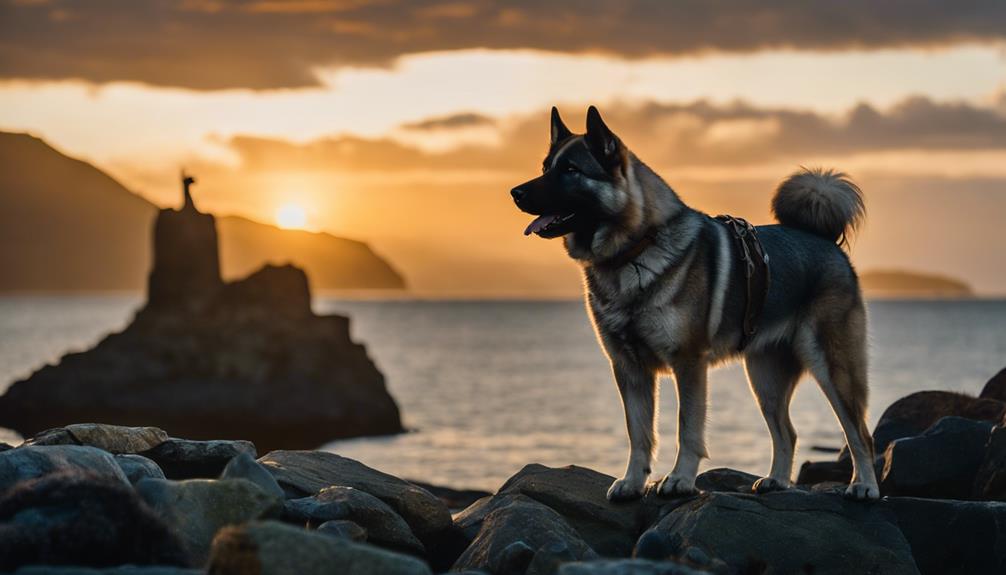
Exploring the Viking heritage of Norwegian Elkhounds reveals their crucial role alongside Vikings. These dogs were bred for hunting big game like wolves, bears, and moose. Their sturdy spitz-type build and lush silver-gray coat are key indicators of their ancient roots, deeply connected with Viking life. Norwegian Elkhounds were known for their exceptional endurance and tracking abilities, qualities vital for Vikings on their hunting trips. The breed’s noble demeanor also reflects the formidable essence of their Viking handlers.
| Feature | Viking Heritage Importance | Breed Impact |
|---|---|---|
| Endurance | Vital for lengthy hunting trips | Improved stamina |
| Tracking Ability | Crucial for finding big game | Advanced scenting abilities |
| Robust Build | Fit for the tough Nordic weather | Versatility across different environments |
| Silver-gray Coat | Blends in with snowy surroundings | Unique look |
This summary underlines the significance of Norwegian Elkhounds’ Viking background, showcasing the breed’s unique traits that have been honed over centuries. Their 98% genetic match with the Jämthund, another Nordic breed famed for its hunting skills, further highlights the Norwegian Elkhound’s rich history and the enduring qualities that mirror their Viking ancestry.
Viking Companion Origins
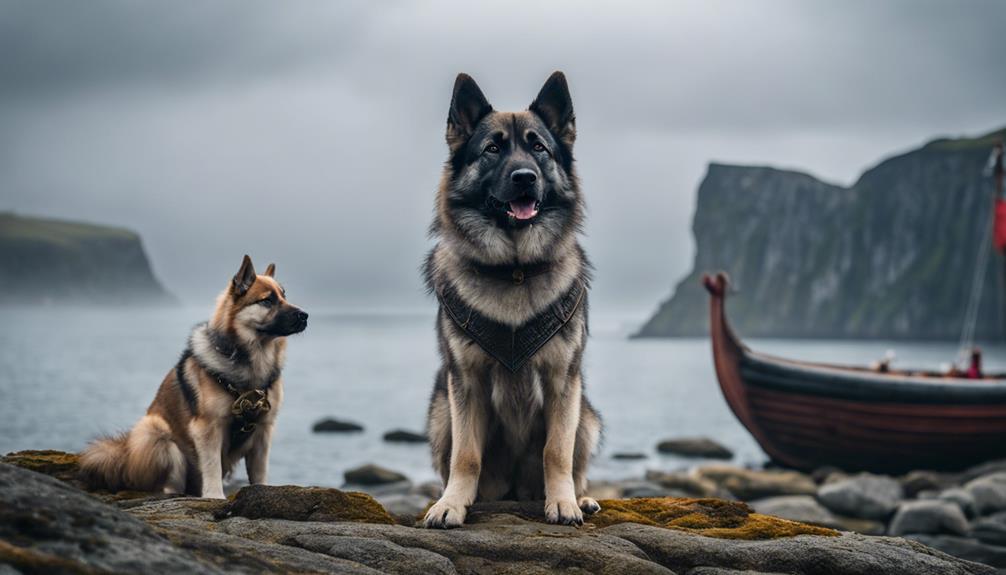
Tracing the roots of the Norwegian Elkhound reveals their deep connection with Norse culture. These dogs were essential for hunting and played a significant role in Viking daily life, making them invaluable companions. Their evolution from ancient protectors to beloved family pets is a testament to their versatility and lasting significance.
The loyalty of Norwegian Elkhounds is a reflection of the strong family ties valued by the Vikings. Their bravery in hunting and resilience in facing challenges were key to their survival. These dogs were also known for their ability to adapt, joining the Vikings on their long sea journeys, demonstrating their unwavering loyalty and ability to withstand various environments.
As Norwegian Elkhounds transitioned into family pets, their intelligence and adaptable nature became even more apparent. Today, they continue to be cherished as both working dogs and companions, showcasing their timeless value and connection to history.
Ancient Viking Roles
In the harsh terrains of Scandinavia, the Norwegian Elkhound was more than just a pet to the Vikings; it played a critical role in their survival. Known for its exceptional ability to track and hunt large animals like elk, bears, and moose, this breed was a key source of food for the Vikings. Its sharp sense of smell and stamina made it perfect for the job.
Beyond hunting, the Norwegian Elkhound was valued for its intelligence and loyalty. These dogs guarded Viking settlements and were trusted companions during long voyages. Their adaptability to different environments and climates made them invaluable.
The bond between these dogs and their Viking handlers was strong, showcasing their versatility and loyalty in various roles within Viking society.
Historical Significance
The Norwegian Elkhound has a deep-rooted history as a Viking companion, bred in the harsh terrains of Scandinavia for its exceptional hunting skills and steadfast loyalty. These dogs played a crucial role in the Viking lifestyle, not only for hunting large animals like wolves, bears, and moose but also for their adaptability during long voyages. Their ability to thrive in various roles on these expeditions showcases their significance as versatile working dogs.
Sharing a remarkable 98% of their genetics with the Jämthund, another spitz-type breed from Scandinavia, the Norwegian Elkhound’s heritage is a testament to their enduring qualities. This breed’s development over time emphasizes a history rich in companionship and loyalty, making them valued assets in their historical context and continuing into the present day.
Modern Day Legacy
The Norwegian Elkhound has a rich history that dates back to its time with the Vikings, serving as both a fearless hunter and a faithful companion. Nowadays, this breed is still cherished for its hunting skills and its adaptability as a family pet. Known for their loyalty and intelligence, Norwegian Elkhounds excel in tracking large game like wolves and moose, traits that have made them beloved by modern families looking for a versatile dog.
With a genetic heritage that is closely related to the Jämthund, making them 98% similar, the Norwegian Elkhound demonstrates both its ancient roots and its ability to adapt over the years. The breed was officially recognized in 1901, highlighting its enduring appeal. In countries like Sweden, the Norwegian Elkhound is highly valued not just for its ability to hunt but also for being a loyal companion to its human family.
Medium Build
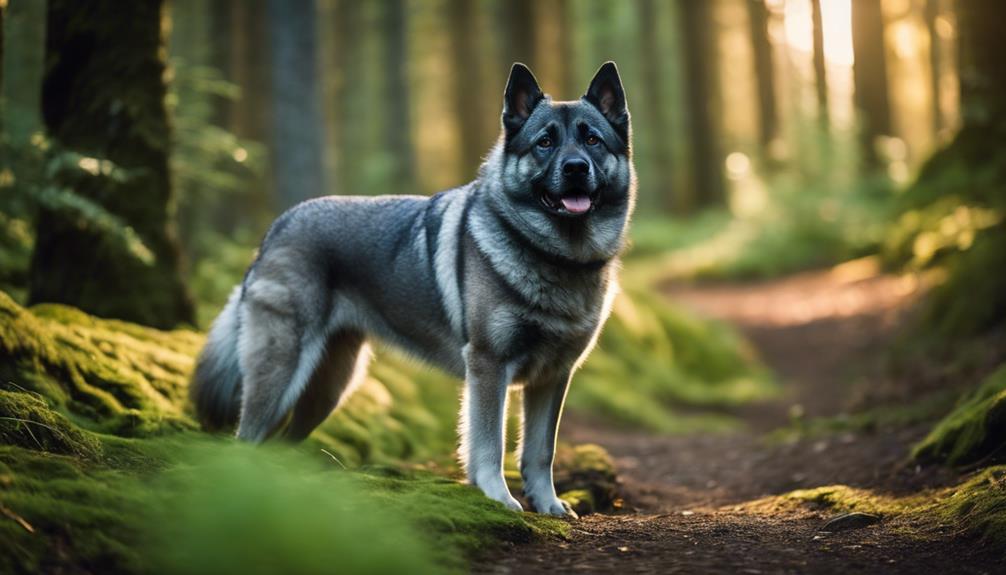
The medium build of the Norwegian Elkhound plays a vital role in its overall health and ability to perform, especially given its history as an active and versatile breed. It’s important for both new and seasoned owners to be aware of several key aspects to ensure the breed’s well-being and life span. These aspects include maintaining an ideal weight, meeting their exercise needs, understanding health issues they may face, providing a balanced diet, and keeping up with their grooming.
Ideal Weight Range is crucial to prevent health issues related to obesity or underweight conditions. Keeping your Norwegian Elkhound within a healthy weight range helps avoid stress on their joints and organs.
Exercise Needs are significant for this breed. Daily physical activity is not just a preference; it’s a necessity to keep them fit and prevent boredom. A mix of walks, play sessions, and mental stimulation will keep them happy and healthy.
Common Health Concerns include hip dysplasia and eye problems. Regular vet check-ups can catch these issues early, which is why they’re an important part of care for this breed.
When it comes to Diet and Nutrition, a balanced diet tailored to their specific age, size, and activity level is key. High-quality dog food can support their energy levels and keep their coat shiny.
Grooming Needs are also part of the package with a Norwegian Elkhound. Regular brushing is needed to manage shedding and keep their coat in good condition.
Understanding and addressing these areas will help ensure your Norwegian Elkhound leads a happy, healthy life. Engaging in regular physical activities, providing a balanced diet, conducting frequent health check-ups, and maintaining grooming routines are essential practices for any owner of this distinguished breed.
Ideal Weight Range
Keeping a Norwegian Elkhound at a healthy weight is vital for their well-being. For male dogs, aim for a weight between 45-55 pounds and for females, 35-45 pounds. This helps avoid health problems and can even extend their lifespans.
A balanced diet and regular exercise are key to preventing obesity in these dogs. Weight issues can lead to joint problems, making it hard for them to move and enjoy life. An overweight Norwegian Elkhound might also have a shorter lifespan, highlighting the need for careful weight management.
It’s smart to work with a vet to create a diet and exercise plan that’s right for your dog. This plan should consider the dog’s age, how active they are, and their general health. Customizing care for your Norwegian Elkhound ensures they stay within a healthy weight range, leading to a happier life.
Exercise Requirements
Norwegian Elkhounds need plenty of exercise daily, at least 40 minutes of intense activities, to keep up with their high energy and stay healthy. They have a strong, medium-sized build that makes them agile and robust, perfect for demanding physical activities. To keep them both physically and mentally fit, it’s vital they get regular outdoor exercise.
Their instinct to hunt and chase means they love activities that let them use these skills. Hiking, running, and agility training are excellent ways to keep them engaged and prevent any unwanted behaviors. It’s clear that keeping up with their exercise needs is crucial for a happy and healthy Norwegian Elkhound.
Common Health Concerns
Norwegian Elkhounds, despite their sturdy build, face several health challenges. Hip dysplasia is a common issue in these dogs, making regular health checks crucial to manage its effects on their movement and well-being.
They are also prone to eye conditions like progressive retinal atrophy, along with kidney issues, cysts, and thyroid problems. These conditions can greatly impact their health and lifespan.
Managing their diet is essential as they can easily gain weight, which can lead to other health problems. Skin allergies are another concern that needs careful attention.
With the right care, Norwegian Elkhounds can live a fulfilling life of 12 to 16 years, sometimes even longer.
Diet and Nutrition
For Norwegian Elkhounds, maintaining a healthy diet is essential to address common health issues such as obesity and joint problems. These medium-sized dogs thrive on a diet that is high-quality and specifically designed for their breed to keep them active and healthy.
It’s important to feed them a balanced diet that includes plenty of proteins and vital nutrients, matching their high energy levels. To prevent health issues related to weight gain, it’s vital to manage their food intake carefully and avoid overfeeding. Always make sure they have access to clean water to stay hydrated.
For personalized advice on the best feeding routine and diet for your dog, talking to a veterinarian is highly recommended.
Grooming Needs
Caring for medium-sized Elkhounds is crucial, especially given their thick double coat. They need regular grooming to avoid matting and too much shedding. The Norwegian Elkhound stands out with its dense undercoat and rough top coat, calling for frequent brushing sessions to clear out loose hair and dirt, ideally a few times every week.
Bathing these dogs doesn’t need to be a regular affair; doing it every one to two months is enough to keep their coat healthy without stripping away essential oils that prevent dryness or irritation.
Keeping up with their grooming involves more than just brushing. It’s important to regularly trim their nails and clean their ears to not only keep them looking good but also to maintain their overall health. Sometimes, taking your Elkhound to a professional groomer can be a good idea. They offer specialized care that can really make a difference, complementing the grooming you do at home.
Loyal and Playful Nature
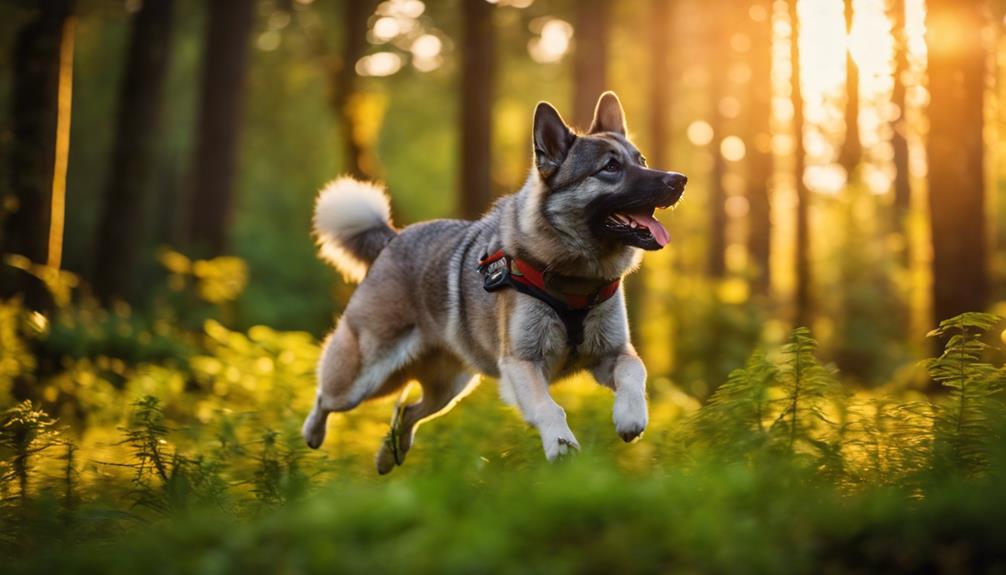
The Norwegian Elkhound is known for its loyal nature and love for playful interactions, making it an excellent companion. These traits not only help to forge a strong emotional connection between the dog and its human family but also keep the dog healthy by ensuring it gets plenty of exercises and mental challenges. It’s vital to understand how their loyalty and playfulness work, including how they behave socially and why play is so important to them, to create a happy and fulfilling life together.
- Loyalty Traits: Their unwavering loyalty deepens the bond with their family.
- Play Activities: Provide mental and physical stimulation through fun games.
- Social Tendencies: Friendly with those they know, but wary around new people.
- Encouraging Playfulness: Training that focuses on play can help maintain their happy nature.
- The Importance of Play: More than just fun, playing together builds trust and strengthens your relationship.
Understanding these aspects of the Norwegian Elkhound can greatly enhance your life with them. Their loyalty and playful spirit are not just charming characteristics but are essential to their happiness and health.
Traits of Loyalty
Norwegian Elkhounds are deeply loyal to their owners, creating strong emotional connections and always ready to protect. Their loyalty isn’t just about being loving; it’s also about being great watchdogs. They use their sharp senses to watch over their homes, keeping everyone safe. This behavior comes from their history as hunting dogs, where they had to work closely with humans to find and catch big animals. This has made them trusted and faithful partners.
Their need to protect is a big part of their loyalty, making them very important to their human families in many ways.
Engaging Play Activities
Engaging in playful activities with Norwegian Elkhounds taps into their loyal nature and love for life, offering key benefits for their health. These dogs are keen on interactive play, which helps maintain their muscle strength and sharpens their minds. Playing games like fetch, running agility courses, and participating in scent games are in line with their instincts, keeping them mentally and physically fit. These activities are fun ways to challenge their energy in a positive manner, supporting their overall development.
Regularly playing with Norwegian Elkhounds strengthens the bond between the dog and its owner, improving their ability to socialize. This doesn’t just affect their ability to interact with other dogs but also helps them better integrate into various social settings. It’s vital for their emotional health and ensures they’re well-rounded pets.
Social Behavior Patterns
Inheriting traits from their ancestors, Norwegian Elkhounds are known for their deep loyalty and fun-loving nature, making them more than just pets but cherished family members. These dogs build strong connections with their humans, engaging in activities together and showing a commitment that is hard to match. Their loving personality is matched by a keenness to interact, ensuring they become central figures in their families.
The protective yet friendly character of the Norwegian Elkhound makes them perfect companions, always ready to be involved in family happenings. Their love for play not only cements the bond with their humans but also showcases their ability to fit into various family dynamics without losing their loyal essence.
Training for Playfulness
Training the Norwegian Elkhound to be playful and loyal involves a mix of fun games, agility training, and obedience lessons. This approach suits their energetic and smart nature, making learning enjoyable for them.
By turning training into a game, we keep them interested and ready to participate. It’s vital to use positive feedback to encourage their playful and loyal sides. This not only makes training more effective but also strengthens the bond between dog and owner.
Plus, it keeps the Elkhound mentally and physically healthy through engaging activities.
Bonding Through Play
Norwegian Elkhounds build a strong bond with their owners through fun and interactive play. These dogs love to be active, and activities like fetch or training sessions help them connect with their humans.
Such playtime is not just for fun; it’s essential for their physical health and helps build a trustful relationship. Elkhounds have a lot of energy, and keeping them engaged prevents boredom and strengthens the emotional bond with their owners.
They are perfect for people who enjoy an active lifestyle and want to involve their pets in their activities. Playing together shows off their happy and loving nature, making the bond with their owners even stronger.
Genetic Health Concerns
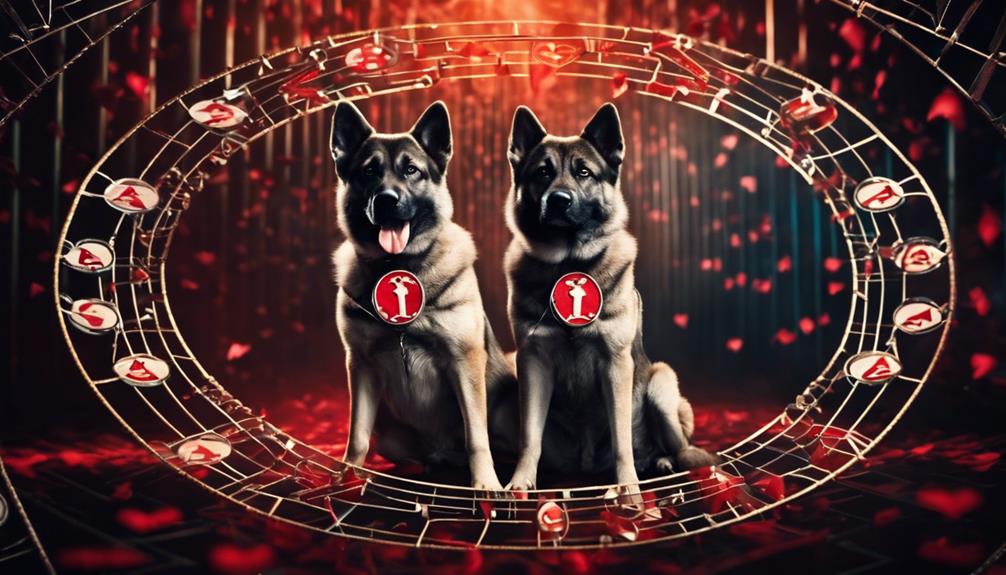
The health of Norwegian Elkhounds involves several concerns that need careful attention and preventive measures. Recognizing their genetic disorders is a crucial step in ensuring they lead healthy, happy lives. With thorough health screenings and appropriate care, we can manage these inherited conditions effectively.
- Progressive retinal atrophy can lead to blindness, making it vital to empathize with affected dogs and their families.
- Hip dysplasia causes discomfort and mobility issues, highlighting the breed’s health challenges.
- Kidney problems emphasize the importance of regular vet visits to monitor their health.
- The appearance of cysts and thyroid issues demands careful attention to their complex genetic health.
- Awareness of their tendency to gain weight easily and develop skin allergies underlines the importance of a healthy diet and regular grooming.
Caring for Norwegian Elkhounds means being proactive about their health. Understanding and managing their genetic predispositions can greatly enhance their wellbeing.
Common Genetic Issues
Norwegian Elkhounds face a range of genetic health issues that need careful attention and regular veterinary care. Issues like progressive retinal atrophy can lead to blindness, as it affects the retina’s cells. Hip dysplasia is another concern, causing pain and difficulty in movement due to the hip joint not fitting properly.
Kidney problems can interfere with the body’s ability to remove waste, and thyroid issues may disrupt metabolism, emphasizing the need for vigilant health checks. These dogs also tend to gain weight easily and can have skin allergies, highlighting the necessity for a well-thought-out diet plan and consistent vet visits.
Caring for a Norwegian Elkhound means being proactive about their health to ensure they live a happy, quality life. Regular check-ups are crucial to catch and manage these conditions early, making a significant difference in their overall well-being.
Preventive Health Screening
Preventive health screenings are key to catching and managing genetic health concerns in Norwegian Elkhounds. For these dogs, it’s vital to get genetic tests for progressive retinal atrophy (PRA), a disease that can greatly affect their vision.
Screenings for hip dysplasia are also crucial because this breed is prone to the condition, and catching it early can make a big difference in their quality of life.
Kidney issues and thyroid problems are common in Norwegian Elkhounds, making regular health checks necessary to spot these conditions before they become severe.
The presence of cysts in this breed further highlights the importance of detailed health screenings to detect and address any issues promptly, ensuring the dogs stay healthy and happy.
Managing Inherited Diseases
Norwegian Elkhounds face challenges with inherited diseases such as progressive retinal atrophy and hip dysplasia. It’s essential to be proactive with their health management. Diseases like kidney issues, cysts, and thyroid problems underline the need for regular vet check-ups and careful feeding to prevent obesity and its related health issues. Skin allergies need constant care to stop them from turning into more severe issues.
Genetic testing plays a key role in spotting these health risks early. This allows for immediate action and helps in making informed decisions when breeding. Taking these steps seriously helps reduce the occurrence of these inherited conditions. It ensures the Norwegian Elkhound breed remains healthy and strong, continuing their legacy as dependable and resilient pets.
Grooming Essentials
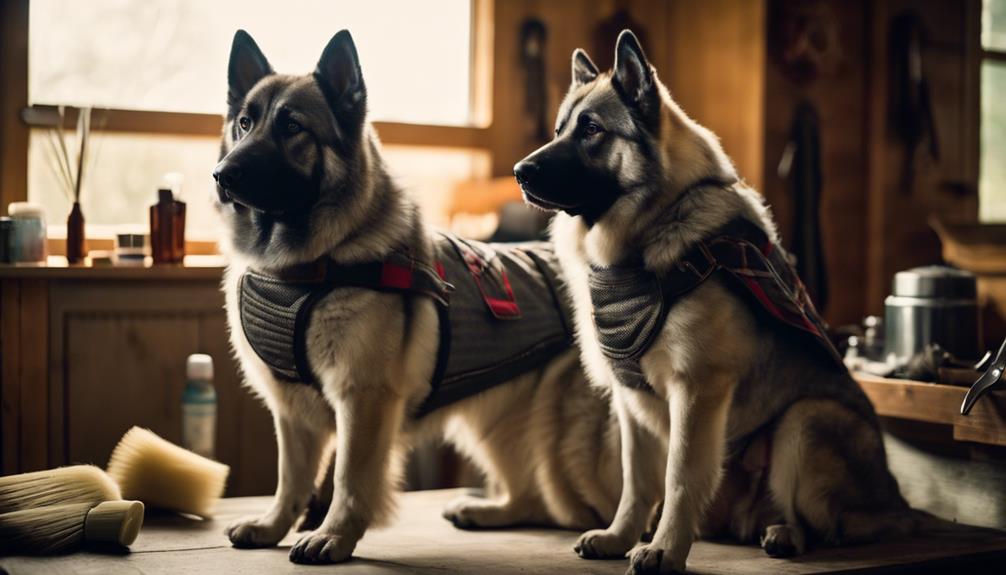
Taking care of a Norwegian Elkhound’s coat is essential for their overall health and appearance. A regular grooming routine can help control shedding, prevent tangles, and keep their coat shiny and in good condition. Here are some key practices that every Elkhound owner should follow.
Coat Care Routine: It’s important to have a regular schedule for grooming. This keeps the coat in top shape and the dog comfortable.
Brushing Techniques: Using the right tools and methods is critical for reducing shedding and avoiding mats in the fur.
Nail Trimming: Keeping the nails short is necessary to avoid discomfort and problems with walking.
Bathing Frequency: It’s crucial to find a balance in bathing schedules to maintain natural oils in the coat while keeping the dog clean.
Ear Cleaning: Regular cleaning is necessary to prevent infections and maintain good hearing.
Taking care of your Elkhound’s grooming needs isn’t just about keeping them looking good. It’s also about their health and comfort. By following these simple steps, you can ensure your dog stays happy, healthy, and looking great.
Coat Care Routine
Taking care of a Norwegian Elkhound’s thick double coat is more than just a chore; it’s key to keeping them happy and healthy. This breed is known for its heavy shedding, making regular brushing a must. Brushing their coat 2-3 times a week helps prevent tangles and keeps shedding under control. When it comes to baths, less is more. Over-bathing can strip their coat of essential oils, so only bathe your dog when really needed.
Grooming doesn’t stop at the coat. Keeping their nails trimmed, ears clean, and teeth brushed are all part of the package. During shedding seasons, pay extra attention to their undercoat to avoid mats. For those tricky areas like paws and ears, sometimes it’s best to call in a professional groomer.
Brushing Techniques
Understanding how to properly groom a Norwegian Elkhound is crucial because of its thick double coat. Weekly brushing is a must, and using the right tools, like a slicker brush or a double-coated breed comb, makes a big difference. Start at the head and work your way towards the tail, paying extra attention to spots that easily get tangled.
This careful brushing technique is not just about preventing mats and getting rid of loose hair. It also helps spread the dog’s natural oils throughout its coat, which keeps the coat healthy and reduces shedding. Moreover, spending this quality time grooming your Norwegian Elkhound strengthens your bond, highlighting the dual benefits of grooming: maintaining a healthy coat and building a stronger relationship with your pet.
Nail Trimming Importance
Keeping the nails of your Norwegian Elkhound trimmed is crucial for their health and comfort. If their nails get too long, they can experience pain and difficulty in walking. This can lead to changes in how they stand and move, which might cause joint pain or even injuries over time. Regular nail trims help avoid these issues, ensuring that your dog can walk and run comfortably.
It’s best to maintain the nails at a proper length to prevent any discomfort for your dog. If you’re unsure how to trim their nails safely, consider asking for advice from your vet or a professional groomer. They can show you the right way to do it, making sure your Norwegian Elkhound stays active and happy.
Bathing Frequency
Norwegian Elkhounds need a bath every 6 to 8 weeks to keep their coat in top shape. The right bathing schedule depends on how much time they spend outside and their unique needs. Bathing too often can strip their coat of essential oils, but waiting too long can lead to dirt buildup and skin issues.
Between baths, regular brushing is key to handle shedding and keep their coat smooth. Use shampoos and conditioners made for dogs to avoid irritating their skin and to protect the coat’s natural shine.
If you’re unsure about how often to bathe your dog or what products to use, getting advice from a professional groomer or veterinarian is a smart move. They can offer guidance tailored to your dog’s specific requirements. Keeping up with these grooming practices ensures your Norwegian Elkhound stays healthy and happy.
Ear Cleaning Tips
Taking care of a Norwegian Elkhound extends beyond just regular baths. Proper ear care is crucial for their health. It’s important to clean their ears regularly to avoid infections. Use a vet-approved ear cleaner and gently clean the outer ear with a cotton ball or a soft cloth. Make sure not to poke anything into the ear canal as it could hurt them.
While cleaning, always look out for signs of trouble like redness, swelling, or bad smells. These could be signs of an infection. Adding ear cleaning to your dog’s grooming routine is key for their comfort and health. It shows how important this step is for taking good care of them.
Dietary Requirements
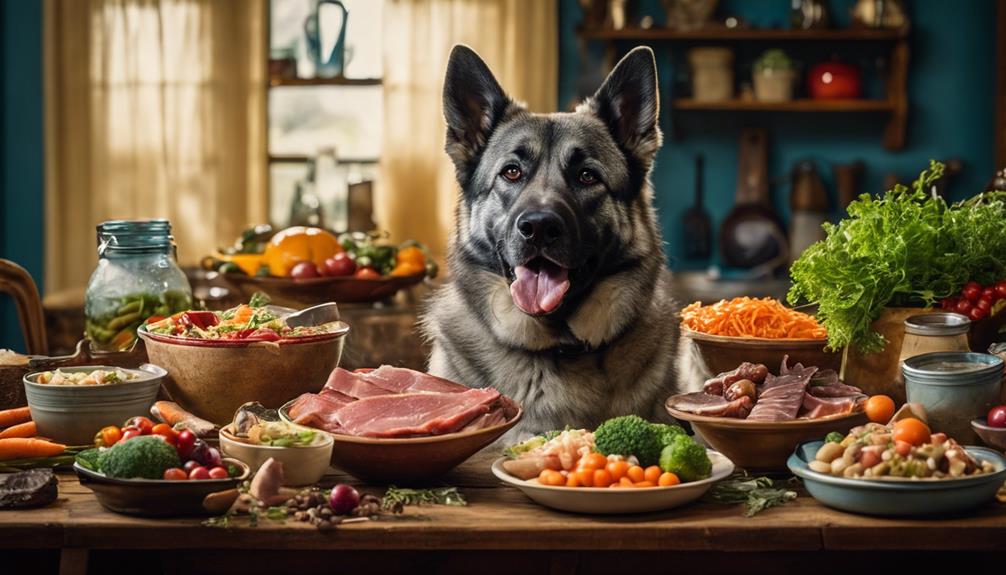
Meeting the dietary needs of Norwegian Elkhounds is essential for their well-being. Choosing the right food and ensuring they eat well at every stage of their life supports their health, longevity, and happiness. It’s important to match their diet with their age, how active they are, and any specific health issues to help them live their best life.
High-quality dog food is key for keeping them healthy. A diet with the right balance of nutrients helps them fight off sickness. Keeping them at a healthy weight is important for their energy levels and ability to move around easily. Making sure they drink enough water is critical for their body’s functions. Checking in with a vet regularly makes sure their diet is on track.
Here’s a breakdown of what to focus on:
- Opt for premium dog food that’s rich in nutrients.
- Ensure they get a balanced diet to prevent diseases.
- Maintain a healthy weight to boost their energy and mobility.
- Always have fresh water available to keep them hydrated.
- Regular vet visits are crucial to confirm their diet is suitable.
Nutritional Needs Overview
Knowing what to feed Norwegian Elkhounds is key because they need a high-quality diet with plenty of animal proteins to keep up with their energy levels. Since they’re at risk for bloating, it’s smart to give them several small meals a day instead of a few big ones to help prevent it.
Overfeeding is a problem too, as it can lead to weight gain that’s bad for their joints and can cause other health issues related to being overweight. That’s why their diet needs to have the right balance of nutrients, including omega-3 fatty acids, which are great for their coat and joints.
It’s a good idea to talk to a vet to figure out exactly what your Norwegian Elkhound needs based on their age, how active they are, and their overall health. This helps make sure they’re getting everything they need to be healthy and happy.
Ideal Food Choices
Choosing the right food for your Norwegian Elkhound means picking a high-quality diet that matches their age, size, and how active they are. These dogs do best with meals packed with protein, fats, vitamins, and minerals. It’s key not to give them human food, especially things like chocolate, grapes, and onions, which can be harmful. Adding foods rich in omega-3 fatty acids is great for keeping their coat and skin in top shape.
It’s smart to chat with a vet about the best feeding times and how much to feed your dog. This ensures your Norwegian Elkhound gets what they need for a healthy life without the risk of becoming overweight.
Managing Weight Healthily
Keeping Norwegian Elkhounds at a healthy weight demands careful monitoring of their diet and sticking to a regular feeding routine. Since they can gain weight quickly if they eat too much, it’s vital to manage their food intake closely. Consistent exercise is crucial to prevent obesity, which can lead to health problems like joint issues and shorten their lives. A diet that’s closely watched, together with regular physical activity, is key to their health.
It’s also a good idea to talk to a vet to create a diet that meets the specific nutritional needs of a Norwegian Elkhound. This ensures they get the right nutrients without too many calories, keeping them healthy and happy.
Frequently Asked Questions
Is a Norwegian Elkhound a Good Family Dog?
- Norwegian Elkhounds excel in families due to loyalty.
- Smart and loving, these dogs make great companions.
- Proper socializing ensures they’re trustworthy watchdogs.
Are Norwegian Elkhounds Cuddly?
- Norwegian Elkhounds love being close to their owners.
- These dogs often show affection through cuddles.
- Cuddling improves bonding and happiness at home.
Are Norwegian Elkhounds Rare in the Us?
- Norwegian Elkhounds are common in the US.
- Breeders maintain their steady presence.
- AKC acknowledges them, ensuring quality.
Are Norwegian Elkhounds High Maintenance?
- Norwegian Elkhounds require frequent brushing due to their thick coats.
- Year-round shedding demands regular grooming to avoid fur mats.
- Consistent care is crucial for their well-being and hygiene.

